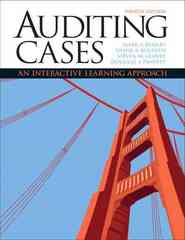Answered step by step
Verified Expert Solution
Question
1 Approved Answer
Goodwill impairment testing is a crucial aspect of the audit process, particularly for companies that have acquired other businesses. Goodwill represents the premium paid for
Goodwill impairment testing is a crucial aspect of the audit process, particularly for companies that have acquired other businesses. Goodwill represents the premium paid for an acquired company above its net identifiable assets, and it must be tested annually for impairment or reduction in value. Here's a detailed overview of the audit procedures for goodwill impairment:
Understanding the Business:
The audit team begins by gaining a thorough understanding of the client's business operations, including recent acquisitions, business strategies, and industry conditions.
They review the company's financial statements, acquisition documents, and disclosures related to goodwill to understand the nature and composition of goodwill balances.
Assessment of Reporting Units:
Goodwill is allocated to reporting units, which are the lowest level of operations that generate cash flows independently of other business segments.
The auditors evaluate the appropriateness of the reporting units identified by management and assess whether they align with the company's internal reporting structure and strategic objectives.
Identification of Potential Impairment Indicators:
Auditors identify potential indicators of goodwill impairment, such as adverse changes in market conditions, declines in cash flows, or negative industry trends.
They analyze qualitative factors, including changes in business strategy, management's assessment of risks, and regulatory developments, that may indicate impairment.
Performance of Impairment Test:
Auditors perform quantitative impairment tests to determine whether the carrying amount of goodwill exceeds its fair value.
They utilize various valuation techniques, such as discounted cash flow analysis, market comparables, and thirdparty appraisals, to estimate the fair value of reporting units and compare it to their carrying amounts.
Assessment of Assumptions and Inputs:
Auditors evaluate the reasonableness of management's assumptions and inputs used in the impairment test, such as cash flow projections, discount rates, and growth rates.
They assess the appropriateness of key assumptions and challenge management's estimates if they appear to be overly optimistic or unsupported by evidence.
Documentation and Disclosures:
The audit team documents the procedures performed, findings, and conclusions reached regarding goodwill impairment testing.
They review the adequacy and completeness of disclosures in the financial statements related to goodwill impairment, ensuring compliance with accounting standards and regulatory requirements.
Fill in the Blank Question:
During the audit of goodwill impairment, auditors assess whether the carrying amount of goodwill exceeds its
A Historical Cost
B Fair Value
C Accumulated Amortization
D Book Value

Step by Step Solution
There are 3 Steps involved in it
Step: 1

Get Instant Access to Expert-Tailored Solutions
See step-by-step solutions with expert insights and AI powered tools for academic success
Step: 2

Step: 3

Ace Your Homework with AI
Get the answers you need in no time with our AI-driven, step-by-step assistance
Get Started


